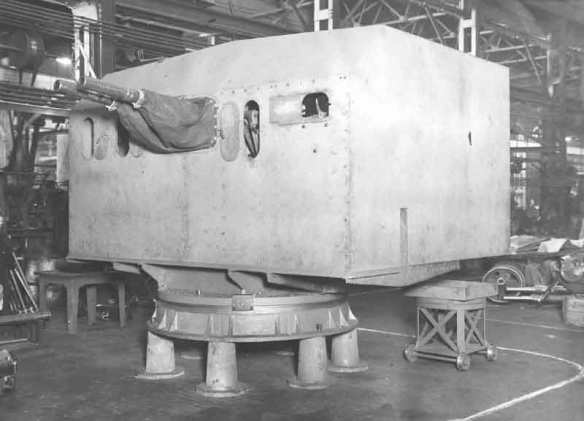Adopted in 1937 and designed for defense against smaller and faster vessels, the dual-mounted 6-pdr, 10-cwt Mk1 Twin had caliber 57mm barrels with semiautomatic vertical sliding breech mechanisms. The Mk1 fired a 6-pound shell up to 5,151 yards.
Twin 6-pdr coastal guns. The short range of these guns was more than compensated for by their high rate of fire which made them very effective against MTB attacks. ‘Twin Sixes’ totally disrupted such an attack by the Italians on Malta in July 1941, sinking five boats in two minutes.
By the middle 1920s, however, some rationalization became necessary and the three roles previously referred to were firmly laid down. While numbers of the 4.7-in (‘120-mm) guns remained in use, it was considered that the 6-in (152-mm) guns could take care of most armoured vessels, but what was needed was a fast-firing weapon to deal with motorboats. After experimenting with 2- pdr pom-poms, a design of two-barrelled 6-pdr was developed, with the two guns carried side-by-side in an armoured turret.
Gun control was entirely by data transmitted from an observing station, with gun sights provided for emergency use only. The guns were capable of being moved in relation to the sights, so that the gun captain could adjust them to cater for aim-off while the gunlayers attended strictly to their dials. Two teams of gunners hand-loaded the guns and a firing rate of 120 rds/min was possible. These ‘twin sixes’ totally disrupted an Italian torpedo-boat raid on Malta in July 1941, sinking five boats in two minutes. In the years after the Second World War the coast defences were maintained for some time, but eventually it was appreciated that a 9.2-in (234-mm) gun in a concrete pit was of little use against an ICBM and in 1956 the coast branch of the Royal Artillery was disbanded and the guns scrapped.
#
On July 24, the merchant ships entered Grand Harbour accompanied by a number of destroyers and unloaded 65,000 tons of stores. The cargoes included 2,000 tons of frozen meat, 2,000 tons of edible oil and large quantities of sugar, coffee, tea and fats to last till October.
The Xa Flottiglia MAS, the elite unit of the Italian navy, the Regia Marina, planned a surprise attack on the ships in harbour, which fortunately failed.
On July 25, 1941, at about 10.30 p.m. the RAF radar station AMES 502 atop Madliena detected a large vessel about 45 nautical miles to the north-north-east of Malta. It was the Diana, which half-an-hour later unloaded ten MT barchini. She then retired northwards while the Xa Flottiglia MAS boats began their trip towards Malta. The route was directly southward and at about 2.10 a.m. the next day they stopped five miles north-east of Valletta.
The various craft approached Grand Harbour slowly so as not to alert the defences with their engine noises. The attack started at 4.45 a.m., but the first explosion occurred three minutes later, when a barchino hit another one; the two of them exploded and destroyed half the break-water bridge (which has just been reconstructed).
This is how Charles Grech describes the attack in his book Raiders Passed:
“It was now about 4.45 a.m. We had almost arrived near the Chalet pier, when there was what felt like a minor earthquake, followed by an explosion which seemed to come from the direction of the entrance to Grand Harbour. The searchlights of the coastal forts were lit. One of them shone from the old Sliema Point Battery close by and this was immediately followed by gunfire in a seaward direction.
“We glimpsed a small object racing on the surface of the water, illuminated by searchlights. At first, we thought this was some practice shoot because before the war, there had often been such shoots on small targets, towed by motor launches. However, that explosion soon caused us to think otherwise…”
After the first explosion, the guns of Fort St Elmo, Fort Ricasoli aided by those of Fort St Rocco destroyed or immobilised most of the craft.
At 5.40 a.m. about 30 Hurricanes took off to attack the survivors. In the attack 16 Italians were killed, 18 were taken prisoner and 11 returned to Sicily.
